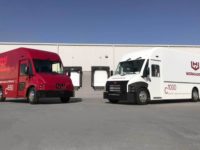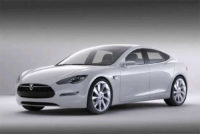The Budweiser Clydesdales have been an advertising icon since April 7, 1933, when the first hitch of eight horses trotted away from the Anheuser-Busch brewery in St. Louis with a wagon-load of beer to celebrate the end of Prohibition.
Some 86 years later, a new, markedly different delivery vehicle pulled away from the brewery, and it might just revolutionize the global transportation industry.
The vehicle was a hydrogen-electric Class 8 truck made by Nikola Motor Co. When the truck hauled a load of beer to a local wholesaler on Nov. 21, 2019, it marked the first commercial delivery by the vehicle.
“We are continuously searching for innovative ways to improve sustainability across our entire value chain,” says Ingrid De Ryck, vice president of procurement and sustainability at Anheuser-Busch, which has committed to reducing carbon emissions across its value chain by 25 percent by 2025.
To help achieve that goal, Anheuser-Busch has ordered 800 hydrogen-electric trucks from Nikola. In fact, the startup, which was founded in 2014, already has backlog of more than 14,000 hydrogen-electric and battery-electric trucks.
The company introduced the Nikola One, a semi-truck with a sleeper cab, in 2017, and the Nikola Two, a day cab version of the One, in April 2019. The Nikola Tre, a cab-over model, was unveiled last December. The latter is a battery-electric version of IVECO’s new S-Way diesel truck for the European market.
The Tre will be made at IVECO’s assembly plant in Ulm, Germany, under a joint venture agreement between Nikola and IVECO’s parent company, CNH Industrial. The Nikola One and Two will be made at a new assembly plant to be built in Coolidge, AZ, a suburb of Phoenix.
“We’ll break ground this summer,” predicts Mark Russell, president of Nikola Motor. “We expect phase 1 to be completed in 2021 and phase 2 to be completed in 2023. We’ll start limited production in 2022 and ramp up in 2023.”
The 1-million-square-foot factory is expected to employ 2,000 people and assemble 35,000 trucks per year. “There will be substantial automation, but we’re not trying to go completely robotic right out of the gate,” adds Russell.
The Nikola One is equipped with hydrogen fuel cells and a 320 kilowatt-hour battery. Six traction motors produce 1,000 hp and 2,000 ft-lb of torque (nearly 86,000 ft-lb after gear reduction). This is sufficient for keeping a speed of 65 mph with a full load of 80,000 pounds on a 6 percent grade. Onboard tanks store 220 pounds of hydrogen, giving the truck a range of 500 to 750 miles.
The truck can accelerate twice as fast as a stock diesel tractor. Torque vectoring allows control of each wheel independently through drive-by-wire. The torque from each wheel is optimized during cornering, maneuvering, accelerating and braking, resulting in better efficiency and stability. With regenerative braking and air disk brakes, the truck can begin braking within 10 milliseconds—hundreds of times faster than advanced air-only disk brakes.
Ironically, Nikola’s newest model, the Tre, will hit the market first. “About 90 percent of the bill of materials for the Tre are stock parts—things like wheels, tires, wiper blades and doors,” says Russell. “As a result, we’ll be able to introduce the Tre to the market this fall and be in mass production in 2021.”
To support its trucks, Nikola plans to operate 700 hydrogen fueling stations by 2028. The initial stations will be located to support the company’s early customers, such as Anheuser-Busch and trucking company U.S. Xpress. Nikola has already built a demonstration station at its headquarters in Phoenix. The stations will be built by Nel ASA, a Norwegian company specializing in the production, storage and distribution of hydrogen.
“It’s a chicken or the egg problem,” admits Russell. “You can’t sell hydrogen-electric vehicles without places to get fuel, but you can’t support the fuel stations if there are no hydrogen-electric vehicles. So, we’re going to build a network of fuel stations at the same time we’re building our trucks.”
Brave New World
Nikola Motor isn’t the only startup hoping to make it big in the nascent electric vehicle market. Not since the early 20th century, when pioneers like Olds, Nash, Hudson, Packard, Studebaker and Ford were launching their businesses, has the U.S. automotive industry seen so many startups.
Late last year, for example, startup Lordstown Motors Corp. purchased GM’s shuttered assembly plant in Lordstown, OH, to produce a new all-electric pickup. In January 2017, startup Rivian Automotive LLC acquired an assembly plant formerly owned by Mitsubishi Motors in Normal, IL. A year later, the company unveiled prototypes for an electric five-passenger pickup and an electric seven-passenger SUV.
“It’s exciting,” says Mark Cuyler, vice president of manufacturing and supply chain for Faraday Future, an EV company founded in April 2014. “When I was growing up in Detroit, the ‘Big Three’ were the only game in town, and the odds of starting a new automotive company were slim. Today, it’s a great time to be in the EV business.”
In August 2018, the company completed the first preproduction version of the FF 91, a luxury electric crossover with a range of more than 350 miles and the ability to accelerate from 0 to 60 mph in less than 3 seconds. Marketed as a consumer’s “third Internet living space,” the interior features a large infotainment screen in the middle of the front dash console. The vehicle’s doors open automatically and can be controlled via smartphone.
“Riding in the 91 will be like flying first class on an airliner,” boasts Cuyler, whose resume includes stints at GM and Tesla Motors.
The base of the 91 is Faraday’s Variable Platform Architecture (VAP), a scalable chassis upon which the company plans to produce a number of variants. “It’s a ‘skateboard,’” says Cuyler. “The VAP will allow us to change the vehicle’s wheelbase without having to do a lot of re-engineering,”
Similarly, Faraday’s battery packs will be produced as “strings” of cells. The 91 will have six such strings. “If we want to produce a city car with a shorter wheel base, we can just take out one or two strings. We don’t have to re-engineer the entire battery pack,” says Cuyler.
In August 2017, Faraday signed a lease for a former Pirelli tire plant in Hanford, CA. However, funding issues have delayed the company’s plans renovate the 1-million-square-foot factory to assemble the 91. “Right now, our assembly process is primarily manual,” admits Cuyler. “Renovations on the Hanford plant are 33 percent complete, and we’re ready to start installing capital equipment.”
When the renovations restart, a priority will be installing the paint line, since that will take nine months to complete. Other capital equipment will be implemented judiciously. “We’re not trying to be 90 percent automated,” says Cuyler. “We will have just enough manufacturing technology to produce the level of quality we want.”
In the meantime, Faraday has completed much of the development work on its assembly processes, such as laser welding the batteries. Cuyler predicts the most difficult aspect of assembling the 91 will be testing the vehicle’s computers, touch screens and other electronics. “Assembling an electric vehicle [by itself] is actually fairly easy,” he says.
EV Startup Gives a Hoot
On Dec. 2, 2019, Lucid Motors Inc. began construction of a $700 million assembly plant in Casa Grande, AZ—a project that could not begin until after a family of burrowing owls living on the site was safely relocated.
“We care about our customers, our people and our environment, so of course we took care of the feathered friends who were living at our factory site,” says Peter Hochholdinger, Lucid’s vice president of manufacturing.
Hochholdinger expects the plant to begin assembling the company’s battery-electric luxury sedan, the Lucid Air, by the third quarter of 2020. The base model will be equipped with a single motor, rear wheel drive setup, producing 400 hp and a 240-mile range. Options include a battery pack with a 400-mile range and a dual-motor, all-wheel drive powertrain producing up to 1,000 hp.
The greenfield facility will enable Lucid to design the plant around its processes. “We don’t have to worry about fitting everything into an existing footprint,” says Hochholdinger. “We’ll start from scratch and do it right.”
Both the body shop and paint shop will be fully automated. The former will include state-of-the-art laser stitch welding technology. The latter will be smaller, more scalable and more energy-efficient than conventional paint lines.
Hochholdinger says the company will be careful about automating the rest of the line. “One EV manufacturer tried [full automation] and was not very successful,” he adds with a wink.
Assembling the chassis for an EV is not all that different from building a chassis for a gas-powered car, says Hochholdinger. “However, assembling the power train and the battery pack are much more complicated. You have to be very precise.”
Fanuc’s massive M-2000iA six-axis robot will be used to load battery packs into the car. “It’s a real monster,” says Hochholdinger.












